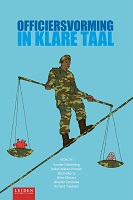Officiersvorming in klare taal
| dc.contributor.editor | Dalenberg, Sander | |
| dc.contributor.editor | Dekker-Prinsen, Ineke | |
| dc.contributor.editor | Folkerts, Ilse | |
| dc.contributor.editor | Klinkert, Wim | |
| dc.contributor.editor | Sanderse, Wouter | |
| dc.contributor.editor | Tieskens, Richard | |
| dc.date.accessioned | 2023-09-04T11:36:32Z | |
| dc.date.available | 2023-09-04T11:36:32Z | |
| dc.date.issued | 2023 | |
| dc.identifier | OCN: 1401618660 | |
| dc.identifier.uri | https://library.oapen.org/handle/20.500.12657/76121 | |
| dc.description.abstract | "Officiersvorming in klare taal" is not the first and certainly not the last publication on officer formation. The importance of officer formation has always been endorsed over time and continues to have plenty of attention today. Each period requires a contemporary answer to the question of exactly what officer formation is and how it takes place. This book is not only about what officer formation is but also contains practical tools and tips on how officer formation can take shape in practice. In the first part of the book, science comes into play. In recent years, virtue ethics, in addition to the ethics of duty and the ethics of consequences, have increasingly found their way into thinking about officer education. Besides a clear exposition of the possibilities of a virtue ethics approach, its limits are also discussed. The first part concludes with a contribution on the relationship between formation and social safety, two concepts that cannot be separated. The second part in this book starts with a historical consideration of officer formation through the years, particularly at the KIM and at the KMA. The perspective is then broadened by also looking at formation of civilian executives at Nyenrode Business University. Foreign perspectives are also covered in essays on officer formation in the United Kingdom and Germany. The third section focuses on stories. In addition to a contribution on the formative value and possibilities of stories in games and films, first-hand experiences of today's officers and trainers are featured. In gripping interviews, they recount the formative events in their lives. It makes clear that formation is not limited to training, but is present always and everywhere. Finally, the fourth part describes the NLDA's current perspective on officer formation. It focuses on the importance of camaraderie and character formation and shows how it is woven into all training. The book concludes with a current look at officer formation as currently developed by the Defense Staff. | en_US |
| dc.language | Dutch | en_US |
| dc.subject.other | officer training; military education; armed forces; education; army | en_US |
| dc.title | Officiersvorming in klare taal | en_US |
| dc.type | book | |
| oapen.identifier.doi | 10.24415/9789087284282 | en_US |
| oapen.relation.isPublishedBy | 276c53fd-5f1d-4065-9fce-9628863ddca8 | en_US |
| oapen.relation.isbn | 9789087284282 | en_US |
| oapen.relation.isbn | 9789087284299 | en_US |
| oapen.imprint | LUP Academic | en_US |
| oapen.pages | 289 | en_US |

